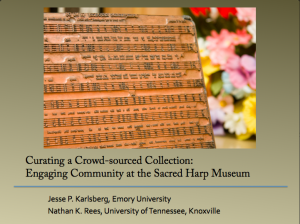We published the seventh issue of the Sacred Harp Publishing Company Newsletter on Wednesday, which “documents the continuing spread of Sacred Harp singing in Europe, sheds new light on important moments in Sacred Harp’s early history, and reports on recent developments at the Sacred Harp Museum.” I contributed to three pieces in this issue:
- I coauthored an essay on Elphrey Heritage, a Philadelphia bookkeeper who was the sole northern contributor to nineteenth-century editions of the Sacred Harp tunebook. Christopher Sawula and I uncovered new details about Heritage’s life and work that help explain how his music came to be included in the book.
- I introduced and annotated this issue’s “Just a Minute” feature: an 1880 memorial to Sacred Harp co-compiler B. F. White included in the minutes of that year’s Chattahoochee Musical Convention.
- Finally, I wrote a “brief history” of Joseph Stephen James’s 1904 A Brief History of the Sacred Harp. Singer David Saylor recently donated a unique copy of this rare book to the Sacred Harp Museum. I discussed the unusual history of this particular copy and the broader significance of the book.
Nathan Rees and I introduced the issue as follows:
Our issue opens with three writers exploring transatlantic Sacred Harp connections from different angles. Álvaro Witt Duarte’s account of the first Germany Sacred Harp Convention documents an important milestone for European Sacred Harp—and a moving and energetic weekend. Ellen Lueck writes from a broader viewpoint on the recent spread of Sacred Harp singing across the Atlantic. Singers who have wondered about what Sacred Harp is like in Europe will be interested to read her thoughtful observations about these dedicated communities far from the singing’s homeland. Chris Brown takes a historical perspective, investigating nineteenth-century English manuscripts to document thesurprising flow of New England hymn and fuging tunes across the Atlantic long before most historians assumed this ever happened. Jesse P. Karlsberg and Christopher Sawula share another tale of music traveling long distances, revealing the fascinating story of how Elphrey Heritage, a Philadelphia bookkeeper, became the sole northern contributor to the 1870 Sacred Harp. We turn from nineteenth-century printing to cutting-edge technology in Clarissa Fetrow’s review of “FaSoLa Minutes,” an iPhone app for searching Sacred Harp songs, singers, and singings. The latest installment of our series on the stories behind our singings’ minutes reprints the 1880 memorial in memory of Sacred Harp co-compiler Benjamin Franklin White, with new commentary on the text’s historical context. Concluding the issue, Nathan Rees reports on the recent digitization of the Sacred Harp Museum’s collection of open-reel tapes, and Jesse describes a rare copy of Joseph Stephen James’s A Brief History of the Sacred Harp, recently donated to the Sacred Harp Museum.
Vol. 3, No. 2 Contents
- “Come Sound His Praise Abroad: A Report on the First Germany Sacred Harp Convention,” Álvaro Witt Duarte (Peabody, Massachusetts)
- “The Old World Seeks the Old Paths: Observing Our Transnationally Expanding Singing Community,” Ellen Lueck (Middletown, Connecticut)
- “American Tunes in West Gallery Sources,” Chris Brown (Elland, United Kingdom)
- “Elphrey Heritage: Northern Contributor to the Nineteenth-century Sacred Harp,” Jesse P. Karlsberg (Atlanta, Georgia) and Christopher Sawula (Tuscaloosa, Alabama)
- “There’s an App for That: A Review of the ‘FaSoLa Minutes’ App,” Clarissa Fetrow (Seattle, Washington)
- “The Chattahoochee Convention, August 1, 1880: Memorial for Benjamin Franklin White,” Jesse P. Karlsberg (Atlanta, Georgia)
- “Our Hope for Years to Come: Digitizing Recordings at the Sacred Harp Museum,” Nathan Rees (Grand Forks, North Dakota)
- “A Brief History of A Brief History of the Sacred Harp,” Jesse P. Karlsberg (Atlanta, Georgia)
